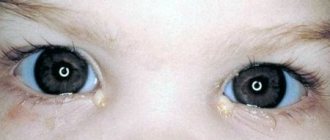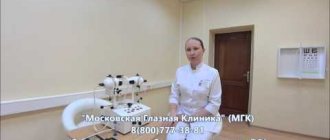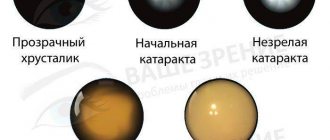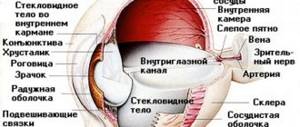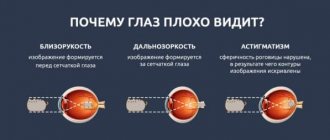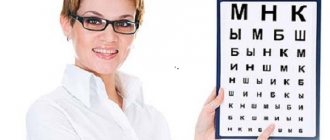Article on the topic “Features of cognitive activity in children with visual impairments”
Features of cognitive activity in children with visual impairments
Vorotyntseva Tatyana Anatolyevna
primary school teacher
highest category
Vision is the greatest value of any person. 80% of information about the world around us comes from vision. There are 37 million blind people in the world and 124 million people with poor vision. Currently, there is an increase in the number of children with visual impairments.
Any visual impairment inevitably affects the visual act, reduces the quantity and quality of perceived information, causes fragmentation, distortion of the perception of objects, slowness and unclearness of their identification. Children with visual impairments have difficulty distinguishing the shape, size, and color of objects; up and down; right and left sides; poorly oriented in space and time. This creates certain difficulties during schooling.
Children with visual impairments need to create comfortable conditions for their stay in the educational environment. Correction and compensation of visual impairments in children does not occur spontaneously, but requires targeted correctional work that levels out difficulties in educational and cognitive activities in this category of children.
The corrective focus of the educational process is carried out in lessons on general education subjects, as well as in classes on social and everyday orientation, the development of visual and tactile perception, spatial orientation, rhythm, and speech therapy.
Lessons, activities, independent activities, and scheduled periods are organized taking into account an individually differentiated approach. The results of a child’s activities are considered only in individual dynamics. This is especially true for children with a complex structure of the defect. This approach ensures positive developmental results for each child.
In the 2012-2013 school year, a boy came to our school in a preschool correctional class. Diagnosis of retinopathy of prematurity, destruction of the vitreous body (total blindness). The boy was active, friendly, and spoke well. I was faced with such a problem that I didn’t know at all what techniques and methods I should use.
The uniqueness of the language program in schools for the blind is that it pays great attention to teaching reading and writing in the Braille system based on the use of tactile-motor sensations. The program provides for the formation of subject concepts that clarify the content of words, the ability to work with relief grammatical diagrams, plot drawings and other special didactic materials. Since I couldn’t teach him to read, I suggested that his parents contact the Society of the Blind, which is located in our city. There, Amir attended classes twice a week and by the end of the year he was already reading syllables.
The development of elementary mathematical concepts in blind children must be carried out in the following directions: 1) orientation in space; 2) orientation in time; 3) differentiation of objects by shape and size; 4) establishing the quantity.
When giving the concepts of “far and near” I used the game “Where am I?” (I talked to the boy standing next to me, then moved far away, and he had to determine by the sound of his voice where I was standing far or close) In the process of learning spatial orientation, I taught the actions and words “down-up”, “closer-further”, “right” -left”, “front-behind”. She conducted training during the game “Where is it hidden?”, starting with a small space and gradually expanding it. I cut out a square and a wide strip from cardboard. To reinforce the concepts, she gave various tasks: “Put the square at the top (above the strip), at the bottom, on the side, in the middle.” During the game, she encouraged me to talk about my actions. At the same time, she stopped him if he spoke quickly, quickly or too slowly and monotonously, showing him how to speak (normal tempo, soft timbre of voice, expressiveness).
She taught equality and inequality of groups of objects like this: she gave Amir three cubes and three circles, asked her to arrange the cubes in a row on the table, then put a circle on each cube. During this task, Amir made sure that there were an equal number of cubes and circles. Ordinal counting was reinforced in a game of the following nature: you need to place different toys in a row and count them (“first, second, third,” etc.). Then I removed one of the toys and asked to tell me which toy I removed.
Studying geometric shapes
Fiction was Amir's favorite subject. He memorized poems well and loved listening to fairy tales. For the New Year, his parents gave him an MP 3 player, they recorded fairy tales on it, and the boy listened every day, and then in class he told all the fairy tales very expressively.
In art classes, Amir had his own paints, he learned the colors by heart, then counted them in order and took the color he needed. The feeling of warmth, softness, tenderness, smoothness was correlated with the soft colors of pink, white, soft green, and hardness, roughness, hardness with the concepts of brown, black, etc. To make the outline of the drawing, glued semolina, the boy determined by touch where can be painted.
Amir participated in all class activities and attended the theater with the class.
In April, the boy passed exams well at a special boarding school for children with visual impairments in Karaganda. Now he is studying there. Amir rides a bike well and goes swimming. Participated several times in swimming competitions. He also wants to sign up for a piano class.
Outdoor games for children with visual impairments
"Find out the figure"
Goal: development of tactile sensitivity, training in the skills of recognizing shapes and naming geometric shapes.
The game is played by two people: an adult (counselor, teacher, mother) and a child.
Equipment: flat geometric shapes (circle, oval, square, triangle, etc.) of two sizes (diameter 25-30 and 3-4 centimeters).
Instructions. Large figures are laid out on the floor, small ones are given one at a time into the child’s hands or put on his wrist in the form of a watch. First, the child examines and feels the small figure on the hand, then goes to look for the same large figure among those lying on the floor. Having found the one he needs, he stands on it and says the name of the figure. The game continues until the child finds all the figures.
Guidelines
· The figures are cut out of cardboard or carpet with a rough surface.
· The “watch” is cut out of cardboard, two holes are made in it, through which an elastic “bracelet” is threaded.
· Healthy children can also take part in the game, in which case they are blindfolded. The game is played against the clock: who will collect the most pieces and name them correctly. Complication options may also be offered.
"Find the ball"
Goal: developing the ability to navigate to localized sound without outside help.
The game is played by two people: an adult and a child.
Inventory: voiced ball (with a bell inside).
Instructions. The leader hides the ball or hides with the ball. After the ball is hidden, the child goes in search of it.
Guidelines
· The ball can be factory-made with a bell sewn inside, or made with your own hands from fabric and a bell.
While the ball is being hidden, the child stands with his ears closed so as not to hear the sound of the ball and the leader’s steps, then the leader opens the child’s ears.
· The game is played up to four times: with sound localization on the right, left, front and back.
· During the search, there should be no obstacles in the child’s path.
"Locomotive"
Goal: development of attention, coordination of movements, ability to handle objects, mastering symmetrical and asymmetrical movements.
The game is played with a group of children of 5-6 people.
Equipment: two gymnastic sticks or smooth slats.
Instructions. All participants line up in a column, taking the slats in their right and left hands with an overhand grip. The leader stands in front and/or behind. On command, synchronized movements of the arms up and down, back and forth, with both hands or separately begin. During the movements, children imitate the sound of a steam locomotive “chug-chug-chug”.
Guidelines
· The game can be played while sitting on a gymnastic bench.
· If the game is played in a standing position, you should move forward or backward.
· Changes in movements occur at the command of the leader.
"Hit the target"
Goal: development of auditory memory and accuracy.
The game is played with a group of four or more children.
Equipment: a target that makes a characteristic sound when hit, a basket with balls.
Instructions. Children line up in a column. At the starting line there is a basket with small balls. Before each player throws, the driver makes short-term sound signals with the target (or tapping next to it). The child then throws the ball at the target from memory. When the target is hit, a sound is heard and the child receives one point. If the throw was unsuccessful, you should bring the child to the target itself and let him touch it. After this, the right to throw passes to the next player. The one who scores 5 points the fastest wins.
Guidelines
· A target can be made by cutting a circle out of a piece of plywood and attaching a tambourine to the back using a nail or other available materials (adhesive tape, plaster).
· The height at which the target is placed should correspond to the child's eye level.
"Catch me"
Goal: development of the ability to navigate in space by moving sound.
The game is played by two people: an adult and a child.
Equipment: a platform without obstacles measuring 5x5 meters, a bell.
Instructions. The adult takes on the role of leader. With the help of a bell, a voiced ball or a tambourine, he makes a constant sound and runs away from the child, who, in turn, catches up with the leader, focusing on the sound.
Guidelines
· The pace of the game is slow, the leader leaves rather than runs away from the child.
· You can help your child with directions, for example: “a little to the right, a little to the left,” etc.
"Hot Ball"
Goal: development of attention, speed, motor reaction and manual dexterity.
The game is played with a group of children (about 10 people) both with and without visual impairments.
Inventory: voiced ball.
Instructions. Children stand in a circle at a distance of 10 centimeters from each other. The announced ball is in the hands of one of the players. At the command of the leader, the ball is passed from hand to hand at maximum speed.
Guidelines
· If visually impaired or healthy children take part in the game, when lining up the players in a circle, the blind child should be placed next to the visually impaired or healthy one, explaining to them that the ball must be given directly to the blind participant in the game.
It is necessary to explain to a blind child how to keep his hands ready (palms up, little fingers touching each other, palms open, elbows pressed to the body).
· The player who drops the ball is eliminated from the game. The game lasts until two remain, who become the winners
Exercise to prevent visual impairment
- “Shooting with the eyes” left and right, up and down 6 times.
- With your eyes, draw 6 circles clockwise and 6 circles counterclockwise.
- Use your eyes to write the numbers from 0 to 9.
- Write your first and last name with your eyes.
- Use your eyes to write the date, month and year of birth.
- Draw springs with your eyes.
- Using your eyes, draw 6 horizontal eights and 6 vertical eights.
- Using your eyes, draw 6 triangles clockwise, then 6 triangles counterclockwise.
- With your left eye closed, write odd numbers from 1 to 9 with your right eye. With your right eye closed, write even numbers from 2 to 10 with your left eye.
10. Draw with your eyes a spring of 12 turns from left to right and vice versa.
11. Draw a geometric figure (circle, square, triangle) with your eyes, first clockwise, then counterclockwise.
Exercise to activate the eye muscles.
- Sit down and relax your body. Open and close your eyes wide at intervals of 30 seconds. Repeat 5-6 times.
- Rotate your eyes in a circle for 2-3 seconds. Repeat 3-4 times.
- Blink quickly for 1-2 minutes.
- Look into the distance for 30-40 seconds. Move your gaze to the finger at a distance of 25-30 cm from the eye and watch for 3-5 seconds. Repeat 3-5 times.
- Using three fingers of each hand, lightly press the upper eyelid of the corresponding eye and hold for 1-2 seconds. Repeat 3-5 times.
- Stretch your arms forward, look at the end of the fingers of your outstretched hand, located along the midline of your face. Slowly move your finger closer without taking your eyes off it. Repeat 3-4 times.
- Move your half-bent right hand with the toy to the side. Slowly move the toy from right to left and follow it with your eyes, return the toy to its original position. Repeat 4-5 times. Performing an exercise for the left hand.
- Look up. Lower your eyes. Turn your eyes to the right side. Turn your eyes to the left. Repeat 3-4 times.
- Turn your head back and try to see objects behind you. Perform the exercise 2-3 times for the right and left sides.
10. Take the ball in your hand. Raise the ball in front of your eyes, open your eyes wide, look at the ball. Drop the ball. Bring the ball to your nose. Take it back to the starting position. Follow the ball with your eyes. Repeat 4-5 times.
11. Extend your arms with the ball forward. Swing your arms left and right and follow the sword with your eyes. Repeat 5-8 times.
Exercises to restore vision
1. Lie on your back. Bend your legs at the knees. Draw a “caterpillar” gait from the bottom up towards the head. Push off with the heel of one foot, then the other. Engage your back, hips, hands on the back of your head. Pat your eyelids, imagine that these are the wings of a butterfly. Continue by starting to draw mirror-symmetrical patterns with your hands. Look at your hands, then through them.
- Stand up, bend your knees. Place your palms behind your ears, thumbs touching your lower jaw. Massage your head with your fingers. Eyes wide open. Raise your head up. Stretch your neck. Wrinkle your mouth to imitate a fish. Look around and pretend to talk to other fish as if you were in the water.
- Sit down and relax your body. Bend over and grab your legs, holding the balls of your feet. Press into your thumbs, exhale, relax your pelvic area. Exhale as you rise. Bend over again, now pressing through your heels. Repeat several times until the pelvic area is completely relaxed.
- Breathe deeply, look into the distance. With your nose, draw horizontal, vertical and diagonal figure eights around the object you are looking at. Do the exercise with several objects.
- Close your eyes and imagine the sun shining on them. Blink your eyes as if catching sunlight. Take a ray of sunshine and look at it with your eyes closed, enjoying the play of colors. Now imagine darkness and relax.
Place your hands together in front of your face. Blink and look at your palms. Let your eyes circle your hands several times. Repeat on the other side. Rest. Then blink and look at only one palm, then the other. Now, with your eyes, “dig” the space on the left, then on the right, then below
Features of the development of children with vision pathology
Subject-based activity can play a huge compensatory role in the development of perception and thinking processes in children with visual impairments. Therefore, game classes should be organized in such a way that the formation of substantive activity becomes the basis of learning. Experts have developed several visually effective methods.
At the same time, it is necessary to continue observation and treatment by ophthalmologists. In the first year of life, it is important to maintain constant close contact with the child. Parents should concentrate their efforts not only on educational play activities, but also on preserving the baby’s vision if possible.
Scientists are confident that a properly organized regular training program will help restore vision.
The number of connections between brain cells continues to increase during the first year of life. Therefore, visual information can gradually reach higher association areas. Then the child begins to realize his visual capabilities. If this happens, the baby will use vision and learn as interneuron connections mature.
Therefore, parents should not give up and give up. It is necessary to use every available opportunity to preserve and develop the remaining vision.

